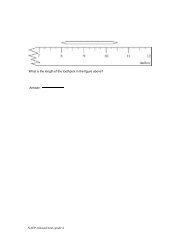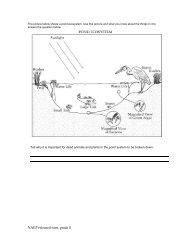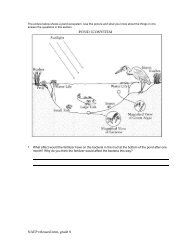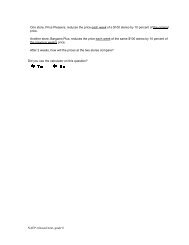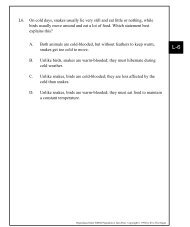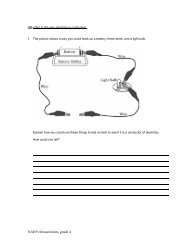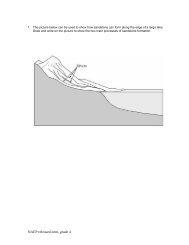Lexington-Who Fired the 1st Shot (N12) - McREL
Lexington-Who Fired the 1st Shot (N12) - McREL
Lexington-Who Fired the 1st Shot (N12) - McREL
You also want an ePaper? Increase the reach of your titles
YUMPU automatically turns print PDFs into web optimized ePapers that Google loves.
The Battle of <strong>Lexington</strong><br />
Passage A<br />
In April 1775, General Gage, <strong>the</strong> military governor of Massachusetts, sent out a body of troops to take<br />
possession of military stores at Concord, a short distance from Boston. At <strong>Lexington</strong>, a handful of<br />
"embattled farmers," who had been tipped off by Paul Revere, barred <strong>the</strong> way. The "rebels" were ordered<br />
to disperse. They stood <strong>the</strong>ir ground. The English fired a volley of shots that killed eight patriots. It was<br />
not long before <strong>the</strong> swift riding Paul Revere spread <strong>the</strong> news of this new atrocity to <strong>the</strong> neighboring<br />
colonies. The patriots of all of New England, although still a handful, were now ready to fight <strong>the</strong> English.<br />
Even in faraway North Carolina, patriots organized to resist <strong>the</strong>m.<br />
Samuel Steinberg, The United States:<br />
Story of a Free People (1963)<br />
Passage B<br />
At five o'clock in <strong>the</strong> morning <strong>the</strong> local militia of <strong>Lexington</strong>, seventy strong, formed up on <strong>the</strong> village<br />
green. As <strong>the</strong> sun rose <strong>the</strong> head of <strong>the</strong> British column, with three officers riding in front, came into view.<br />
The leading officer, brandishing his sword, shouted, "Disperse, you rebels, immediately!"<br />
The militia commander ordered his men to disperse. The colonial committees were very anxious not to<br />
fire <strong>the</strong> first shot, and <strong>the</strong>re were strict orders not to provoke open conflict with <strong>the</strong> British regulars. But in<br />
<strong>the</strong> confusion someone fired. A volley was returned. The ranks of <strong>the</strong> militia were thinned and <strong>the</strong>re was a<br />
general melee. Brushing aside <strong>the</strong> survivors, <strong>the</strong> British column marched on to Concord.<br />
Winston Churchill, History of<br />
<strong>the</strong> English Speaking Peoples (1957)<br />
Passage C<br />
The British troops approached us rapidly in platoons, with a General officer on horse-back at <strong>the</strong>ir<br />
head. The officer came up to within about two rods of <strong>the</strong> centre of <strong>the</strong> company, where I stood.—The<br />
first platoon being about three rods distant. They <strong>the</strong>re halted. The officer <strong>the</strong>n swung his sword, and<br />
said, "Lay down your arms, you damn'd rebels, or you are all dead men—fire." Some guns were fired by<br />
<strong>the</strong> British at us from <strong>the</strong> first platoon, but no person was killed or hurt, being probably charged only with<br />
powder. Just at this time, Captain Parker ordered every man to take care of himself. The company<br />
immediately dispersed; and while <strong>the</strong> company was dispersing and leaping over <strong>the</strong> wall, <strong>the</strong> second<br />
platoon of <strong>the</strong> British fired, and killed some of our men. There was not a gun fired by any of Captain<br />
Parker's company within my knowledge.<br />
Sylvanus Wood, Deposition (June 17, 1826)<br />
Passage D<br />
I, John Bateman, belonging to <strong>the</strong> Fifty-Second Regiment, commanded by Colonel Jones, on<br />
Wednesday morning on <strong>the</strong> nineteenth day of April instant, was in <strong>the</strong> party marching to Concord, being<br />
at <strong>Lexington</strong>, in <strong>the</strong> County of Middlesex; being nigh <strong>the</strong> meeting-house in said <strong>Lexington</strong>, <strong>the</strong>re was a<br />
small party of men ga<strong>the</strong>red toge<strong>the</strong>r in that place when our Troops marched by, and I testify and declare,<br />
that I heard <strong>the</strong> word of command given to <strong>the</strong> Troops to fire, and some of said Troops did fire, and I saw<br />
one of said small party lay dead on <strong>the</strong> ground nigh said meeting-house, and I testify that I never heard<br />
any of <strong>the</strong> inhabitants so much as fire one gun on said Troops.<br />
John Bateman, Testimony (April 23, 1775)<br />
NAEP released item, Grade 12
Based on <strong>the</strong> information contained in <strong>the</strong> passages, what judgment would you make about who fired<br />
<strong>the</strong> first shot at <strong>the</strong> Battle of <strong>Lexington</strong>? Explain why.<br />
Score & Description<br />
Acceptable<br />
Ei<strong>the</strong>r "Colonists" or "British" or "can't tell" is acceptable as long as <strong>the</strong> justification is reasonable<br />
and based on <strong>the</strong> passage. For example:<br />
• "The British because a British soldier says <strong>the</strong>y fired <strong>the</strong> first shot."<br />
• "The British - because most of <strong>the</strong> passages say that <strong>the</strong> British fired <strong>the</strong> first shot."<br />
• "Can't tell because <strong>the</strong>re's disagreement between <strong>the</strong> passages and <strong>the</strong>re isn't enough<br />
information about <strong>the</strong> eyewitnesses to judge <strong>the</strong>ir credibility."<br />
Unacceptable<br />
Unacceptable responses may include:<br />
• "The British fired <strong>the</strong> first shot because someone who was <strong>the</strong>re said so."<br />
• "I would say <strong>the</strong> British because <strong>the</strong> passage says so."<br />
• "The Colonists because Winston Churchill was <strong>the</strong> Prime Minister of England."<br />
Acceptable - Student Response<br />
Based on <strong>the</strong> information contained in <strong>the</strong> passages, what judgment would you make about who<br />
fired <strong>the</strong> first shot at <strong>the</strong> Battle of <strong>Lexington</strong>? Explain why.<br />
Based on <strong>the</strong> information contained in <strong>the</strong> passages, what judgment would you make about who<br />
fired <strong>the</strong> first shot at <strong>the</strong> Battle of <strong>Lexington</strong>? Explain why.<br />
NAEP released item, Grade 12
Scorer Comments:<br />
Both responses provide a judgement and use information contained in <strong>the</strong> passages for support.<br />
The first response refers to specific testimony while <strong>the</strong> second uses <strong>the</strong> discrepancies between<br />
accounts to support not drawing conclusions.<br />
Unacceptable - Student Response<br />
Based on <strong>the</strong> information contained in <strong>the</strong> passages, what judgment would you make about who<br />
fired <strong>the</strong> first shot at <strong>the</strong> Battle of <strong>Lexington</strong>? Explain why.<br />
Based on <strong>the</strong> information contained in <strong>the</strong> passages, what judgment would you make about who<br />
fired <strong>the</strong> first shot at <strong>the</strong> Battle of <strong>Lexington</strong>? Explain why.<br />
Scorer Comments:<br />
The first response makes a judgement but uses personal opinion ra<strong>the</strong>r than information from <strong>the</strong><br />
passage to support it. The second response makes a judgement but provides no explanation.<br />
1992 National Performance Results<br />
Score<br />
Percentage of Students<br />
Unacceptable 56%<br />
Acceptable 40%<br />
Omitted 5%<br />
Note:<br />
• These results are for public and nonpublic school students.<br />
NAEP released item, Grade 12
• Percentages may not add to 100 due to rounding.<br />
Contexts for Reading<br />
Reading for Information<br />
• Involves <strong>the</strong> engagement of <strong>the</strong> reader with aspects of <strong>the</strong> real world<br />
Reading for information is most commonly associated with textbooks, primary and secondary sources,<br />
newspaper and magazine articles, essays, and speeches. Some features that distinguish<br />
informational text from literary text are organization and <strong>the</strong> way information is presented.<br />
Informational text is organized by topic and supporting details, whereas literary text is organized by <strong>the</strong><br />
structure of a story, poem, or drama. Informational texts may have boldface headings, graphics,<br />
illustrations, and captions that signal importance in <strong>the</strong> text. However, some commonalities exist<br />
between literary and informational text and <strong>the</strong> skills and strategies required for reading each. Both<br />
require people to critically analyze <strong>the</strong> text, reflect on it, and draw conclusions.<br />
When reading for information, readers need to know <strong>the</strong> specific text patterns, or forms of organization<br />
(e.g., cause and effect, sequential order, comparison/contrast, opinion and supporting arguments), to<br />
develop understanding. People frequently have different purposes for reading text of this nature-for<br />
example, to find specific pieces of information, answer a question, or get some general information<br />
when glancing through a magazine article. Reading informational text calls for orientations to <strong>the</strong> text<br />
that differ from those used in reading for literary experience because readers are specifically focused<br />
on acquiring information. When people read for information, <strong>the</strong>y may select parts of <strong>the</strong> text <strong>the</strong>y<br />
need, ra<strong>the</strong>r than reading from beginning to end.<br />
Aspects of Reading<br />
Top<br />
Examining Content and Structure<br />
Examining text content and structure requires critically evaluating, comparing and contrasting, and<br />
understanding <strong>the</strong> effect of such features as irony, humor, and organization. Questions used to assess<br />
this aspect of reading require readers to stand apart from <strong>the</strong> text, consider it objectively, and evaluate<br />
its quality and appropriateness. Knowledge of text content and structure is important. Questions ask<br />
readers to determine <strong>the</strong> usefulness of a text for a specific purpose, evaluate <strong>the</strong> language and textual<br />
elements, and think about <strong>the</strong> author's purpose and style. Some questions also require readers to<br />
make connections across parts of a text or between texts. For example, students might be asked to<br />
compare a poem and a story with <strong>the</strong> same <strong>the</strong>me or relate information from a first-person account to<br />
a textbook description of an event. Questions that assess this aspect of reading include <strong>the</strong> following:<br />
• Compare <strong>the</strong> structure of this magazine article to that one.<br />
• How useful would this be for _________? Why?<br />
• Does <strong>the</strong> author use (irony, personification, humor) effectively? Explain.<br />
• What is <strong>the</strong> author's point of view? Using <strong>the</strong> text, provide a sentence or two to support your<br />
response.<br />
• Is this information needed for ________? Explain your reasoning.<br />
NAEP released item, Grade 12
• What o<strong>the</strong>r information would you need to find out about ________? Support your answer with<br />
information from <strong>the</strong> text.<br />
NAEP released item, Grade 12



